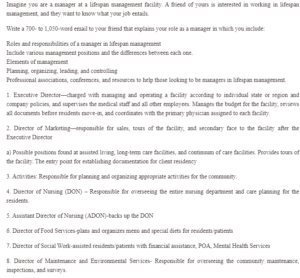Lifespan Management
Hi Anne,
I hope you’re doing well. Further to our conversation regarding your interest in working in a management position at Lifespan, I’ve prepared a brief write-up detailing what a managing job at Lifespan entails and the roles and responsibilities of a manager.
Need help with your assignment? Get in touch with us.
Roles and responsibilities of a manager in lifespan management
Being a manager in lifespan management includes handling tasks that ensure that medical staff in charge of meeting a patient’s healthcare needs focus on improving the patient’s health and, if possible, helping the patient achieve total restoration (Alegbeleye, 2018). One of the roles and responsibilities of the manager in lifespan management is reviewing patient records to ensure that the patients are given proper dietary recommendations. The second responsibility is addressing conflicts between patients and healthcare providers and ensuring that patient’s needs are considered when selecting the most effective lifespan management program, such as changes in lifestyle or adjusting their diet. Managers in lifespan management are also responsible for assigning medical staff to help the patient adhere to the recommendations given for lifespan management.
Include various management positions and the differences between each one.
The leading management positions in lifespan management are activities director, director of nursing, director of food services, and director of social work. The activities director is in charge of planning and organizing appropriate activities for the community. For instance, the activities director may plan the lifestyle changes required to increase a patient’s Lifespan based on their illness and prepare how to adapt to the change without backsliding to old lifestyle habits that may have contributed to the disease being treated. The director of nursing oversees the entire nursing department and care planning for residents by assigning nurses to patients in the lifespan management program based on the nurse’s expertise in taking care of patients with the illness being treated. The director of food services plans and organizes menus and special diets for patients or residents based on recommended dietary changes. The director of social work assists patients or residents with financial assistance, mental health services, and POA, thus helping them adjust to the required changes.
Elements of management
The main elements of management that the manager in lifespan management should consider are cultural competence, patient advocacy, data-informed patient prioritization, and the human element. According to Niles (2018), cultural competence requires understanding a patient’s healthcare beliefs. Patient advocacy includes collaborating with the patient to settle on the most suitable lifespan management approach to ensure they are not forced to accept something they are uncomfortable with. Data-informed patient prioritization includes integrating patient data, such as their medical history, in making decisions on the lifespan management option and any additional resources that may be required to effectively complete the lifespan management program (Brooke, 2019). The human element includes establishing a genuine relationship with patients to create trust.
Planning, organizing, leading, and controlling
Planning will include selecting healthcare providers with the knowledge and expertise required to care for a patient throughout the lifespan management program. Organizing will provide all the necessary resources to implement lifespan management programs. Leading will include setting an example of how healthcare providers should treat patients throughout the lifespan management process. Controlling will consist of monitoring the relationship between the patients and medical staff and assigning tasks to improve the efficiency of the lifespan management program.
Professional associations, conferences, and resources to help those looking to be managers in lifespan management.
Some professional associations that individuals looking to be managers in lifespan management should consider joining are the American Association of Healthcare Administrative Management and the National Association of Healthcare Access Management. The individual could also attend conferences such as the annual lifespan conference and the lifespan network conference. Additionally, a wide range of resources provide information on healthcare management, such as Managing Care by Richard M. J. Bohmer and Healing Our Future by Andrew N. Garman.
Best regards,
Jane Doe
References
Alegbeleye, A. J. (2018). Life span management. Geriatrics Health. https://doi.org/10.5772/intechopen.74730
Brooke, A. (2019). Health care professional & patient consultation – informed decision making. Endocrine Abstracts. https://doi.org/10.1530/endoabs.65.ns1.2
Niles, N. J. (2018). Cultural competence in American healthcare. https://doi.org/10.4135/9781526442048
ORDER A PLAGIARISM-FREE PAPER HERE
We’ll write everything from scratch
Question
Imagine you are a manager at a lifespan management facility. A friend of yours is interested in working in lifespan management, and they want to know what your job entails.

Lifespan Management
Write a 700- to 1,050-word email to your friend that explains your role as a manager in which you include:
Roles and responsibilities of a manager in lifespan management
Include various management positions and the differences between each one.
Elements of management
Planning, organizing, leading, and controlling
Professional associations, conferences, and resources to help those looking to be managers in lifespan management.
1. Executive Director—charged with managing and operating a facility according to individual state or region and company policies and supervises the medical staff and all other employees. Organizes the budget for the facility, reviews all documents before residents move in, and coordinates with the primary physician assigned to each facility.
2. Director of Marketing—responsible for sales, tours of the facility, and secondary face to the facility after the Executive Director
a) Possible positions found at assisted living, long-term care facilities, and continuum of care facilities. Provides tours of the facility. The entry point for establishing documentation for client residency
3. Activities: Responsible for planning and organizing appropriate activities for the community.
4. Director of Nursing (DON) – Responsible for overseeing the entire nursing department and care planning for the residents.
5. Assistant Director of Nursing (ADON)-backs up the DON
6. Director of Food Services-plans and organizes menu and special diets for residents/patients
7. Director of Social Work-assisted residents/patients with financial assistance, POA, Mental Health Services
8. Director of Maintenance and Environmental Services- Responsible for overseeing the community maintenance, inspections, and surveys.

